This post may contain affiliate links. Please read our disclosure policy.
The impossibly light, moist and tender crumb of this cake makes it (yes, really) the very best gluten free vanilla cake you've ever had.
This cake is so light and airy, it proves, once and for all, that gluten free baked goods can be just as good, if not better, than conventional gluten cakes.
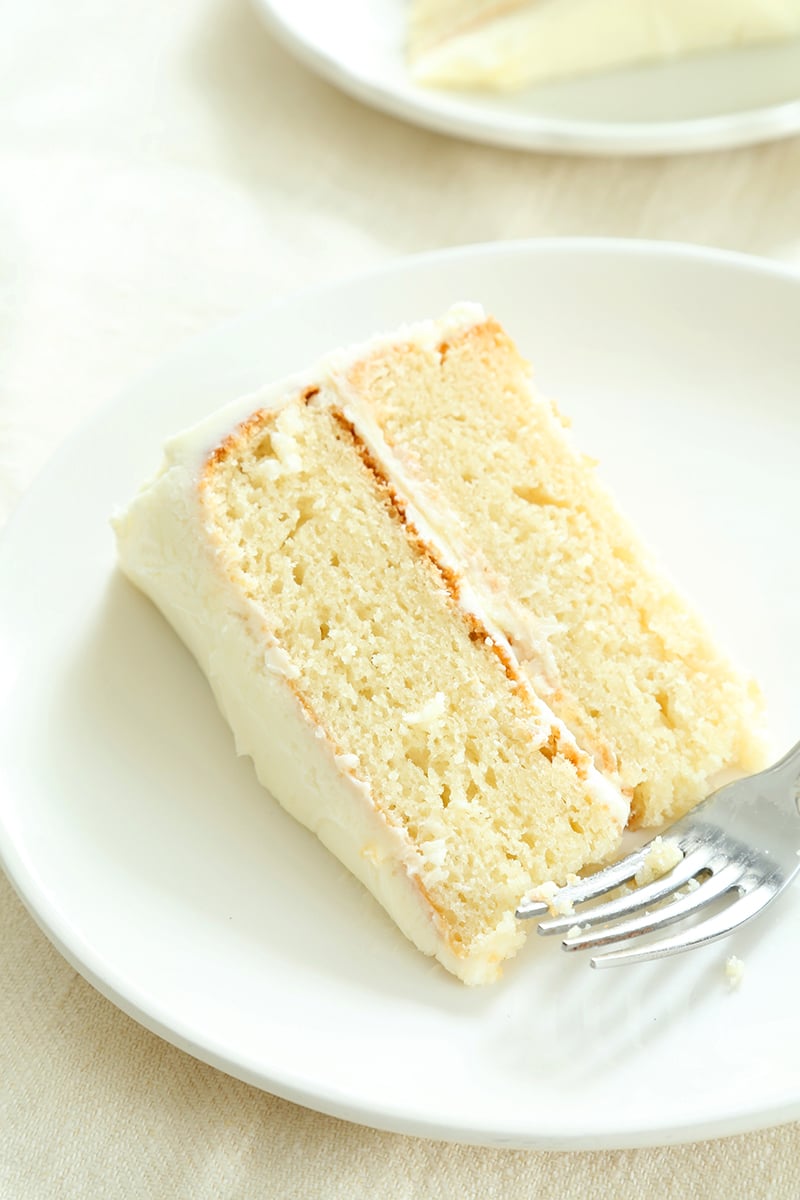
Table of Contents
- What makes this the best gluten free vanilla cake recipe?
- Simple pantry ingredients for a yummy gluten free cake
- Choosing cake pans for this easy gluten free vanilla cake
- Choosing the right gluten free flour blend for a perfect vanilla cake
- Deciding on a frosting for your gluten free vanilla cake
- Storing your gluten free vanilla cake
- Tips for making the best gluten free vanilla cake
- FAQs
- Ingredient substitutions
- Gluten Free Cake Recipe
What makes this the best gluten free vanilla cake recipe?
It may be bold, but this cake isn't just the best gluten free vanilla cake. It's the cake that you serve to people who can eat as much gluten as they want, and they ask if they can make it at home with their conventional flour.
I tell them that they can have the recipe, since it's right here on the blog. But they can't make this cake without our gluten free all purpose flour. They have their recipes; leave us ours.
Please realize you must use one of my recommended all purpose gluten free flour blends for this recipe to work. Please click through for complete information on brands (usually, Better Batter or Cup4Cup), my “mock” recipes to make those blends yourself at home, and information on why they work and why others don't.
The secret to gluten free cake success
The secret to the very best vanilla cake recipe, gluten free, is in the balance of ingredients at the proper temperature—and in the method. Read the recipe through carefully first, follow it closely, and you'll know you can make a vanilla cake, gluten free, with an open crumb and tons of delicate flavor any time. If you'd like to save on time, combine the dry ingredients in step 2 in the recipe below in a sealed container for a sort of dry cake mix to make later.
The most important parts of the method are using one of my recommended gf flour blends, sifting it well, and beating the butter and sugar together until they're light and fluffy. And your ingredients must be at room temperature before you begin, or they won't combine properly no matter what you do.
For more general tips before you begin to assemble your ingredients for this amazing, tender gluten free cake, try reading our beginner's guide to gluten free baking. For a desserts overview, including a guide to the top 20 recipes on the blog, our gluten free desserts guide.
You may notice some negative reviews sprinkled in among the positive ones commenting on this recipe. They were left by people who used the wrong gf flour blend, didn't measure by weight, didn't sift, didn't combine the dry and wet ingredients separately first, beat the butter and sugar for long enough, etc.
In other words, they didn't follow the recipe as written! I wish it were as simple to make a perfect gluten free vanilla cake as it is to make, say, a one bowl gluten free banana bread.
I can only tell it like it is—and happily I can guide you through each step toward complete recipe success. It's all worth it!
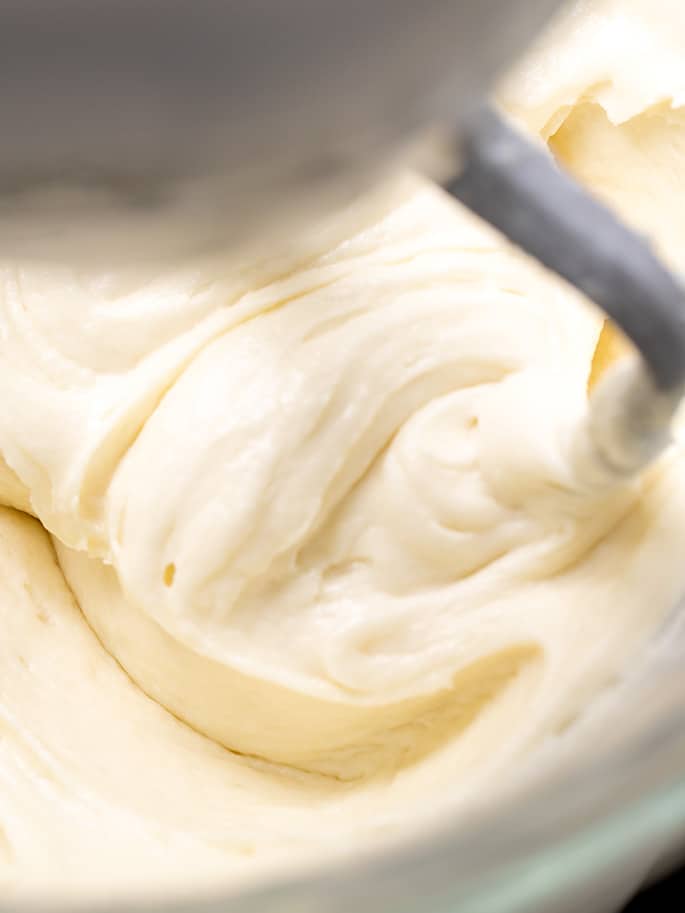
Simple pantry ingredients for a yummy gluten free cake
This cake doesn't call for super specialized ingredients; instead you'll only need classic gluten free pantry ingredients. It's made with basic vanilla cake ingredients like butter, sugar, eggs, vanilla, and buttermilk.
Unlike our one bowl gluten free chocolate cake, to get the best vanilla cake you’re going to have sift the dry ingredients. Yes, you really do have to if you want that super tender, non-grainy crumb.
Then, beat the heck out of the butter and sugar before you even think about adding anything else. A stand mixer is great, but a handheld mixer works just as well provided you’re willing to stand there, beating and beating for at least 3 minutes.

Choosing cake pans for this easy gluten free vanilla cake
I like to bake these cakes in 2 aluminum 8-inch round cake pans to make a layer cake They bake evenly in about 30 minutes at 350°F, and never dome even if my oven has some hot spots (which all ovens do).
If you'd rather bake the cake in 9-inch cake pans, just reduce the baking time accordingly. You'll have to watch it carefully after the initial 20 minutes. And your layer cake will be wider, and a bit less tall.
Don't bake in a dark colored pan or in a glass pan. They attract and conduct too much heat, so your cake may burn on the bottom or the edges before it's baked all the way through to the center.
If you'd like, you can also use 8-inch square pans. The baking time should be the same as with 8-inch round cake pans.
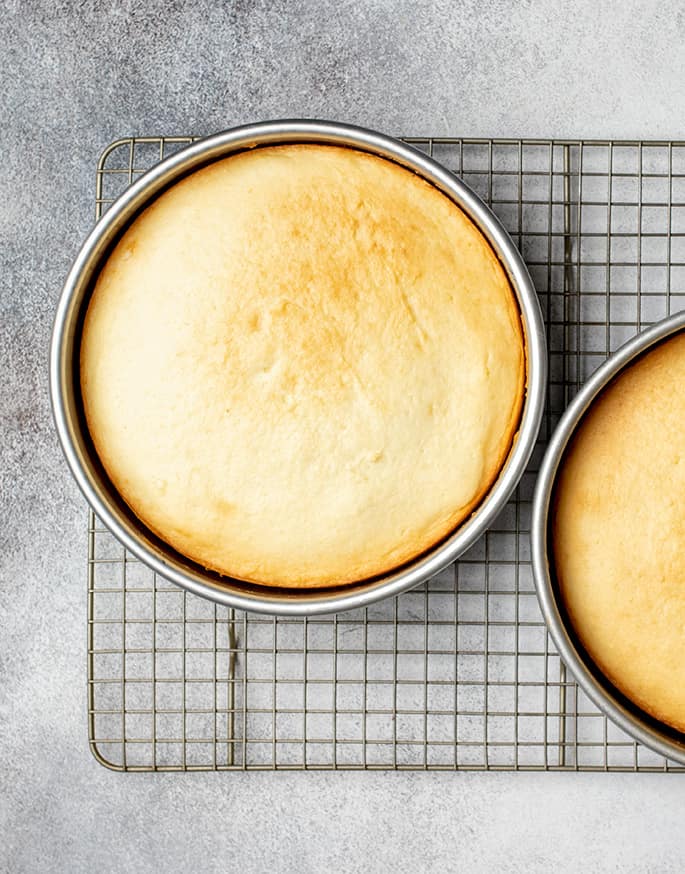
Choosing the right gluten free flour blend for a perfect vanilla cake
I'm partial to Better Batter gluten free flour's original blend for nearly all of my gluten free recipes. If you can't buy it online, you can always use my mock Better Batter blend recipe to make your own.
If you are using a higher starch all purpose gluten free flour blend like Cup4Cup (or my mock Cup4Cup), replace the cornstarch in this recipe with an additional 54 grams of your flour blend.
Do not try to make this recipe using one of the lower-quality flour blends that use gritty, poor quality rice flour. Bob's Red Mill is a particularly bad one, and your cake ingredients won't combine properly—and your cake will taste gritty.
I can't stress this enough. I want you to be successful! This cake may be a bit of a diva, but she's 100% worth it!
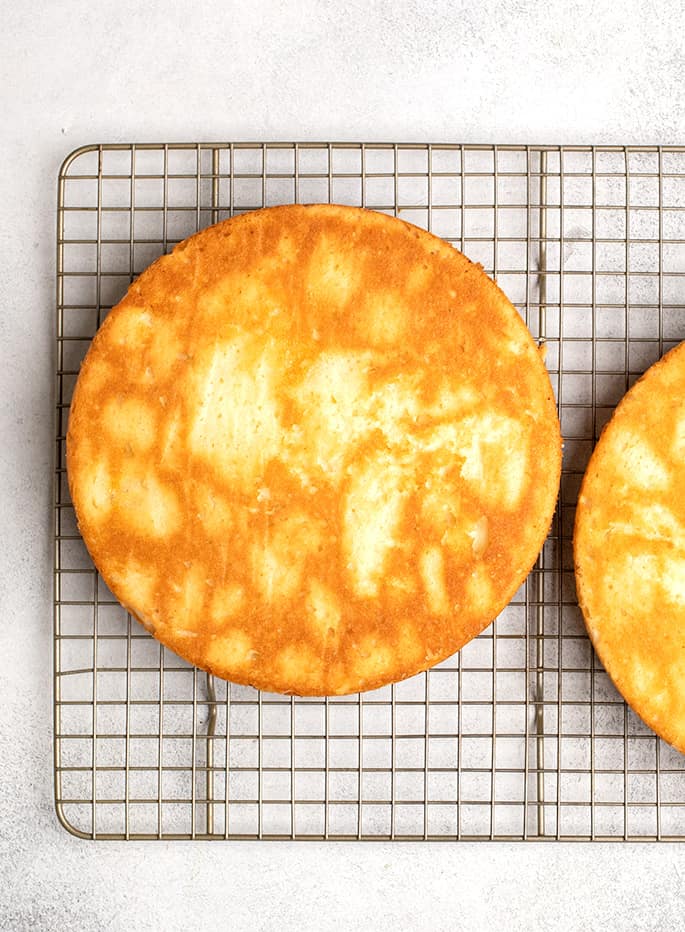
Deciding on a frosting for your gluten free vanilla cake
I usually frost this cake with a stiff vanilla buttercream frosting, especially when I make it into a layer cake. It holds its shape really well and protects the cake from drying out like a softer frosting but without wilting. If you'd really like to dive in, please see our full discussion of gluten free frosting recipes, tips, and FAQs.
The simplest way to a lovely, basic gf frosting is to just beat 10 to 12 tablespoons (140 to 168 grams) unsalted butter, at room temperature, until light and fluffy. Add vanilla extract and/or the seeds from the inside of a vanilla bean, and begin with 2 cups (230 grams) confectioners' sugar.
Beat until well-combined. Add more confectioners' sugar as necessary to make the frosting as stiff as you'd like it.
Test the consistency by running your finger through it, but only after beating the frosting really well. If it's stiff enough, it won't stick to your fingers very much.
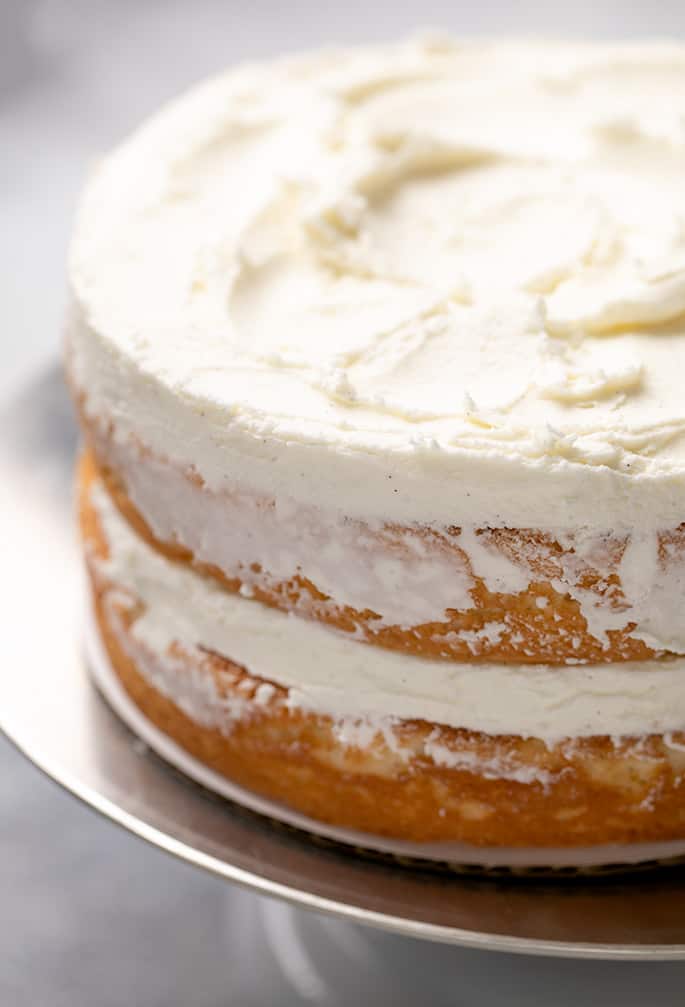
Storing your gluten free vanilla cake
I like the look of a “naked cake,” which just means that it's frosted fully in between the layers and on top. The sides have a very thin crumb coat, and that's enough to keep in the moisture.
If you'd like to serve a few slices of this perfect vanilla layer cake and then store it at room temperature for a few hours, just after taking a slice, use leftover frosting to cover the missing area, extending the cake's life in the fridge.
Tips for making the best gluten free vanilla cake
Beat the room temp butter and sugar well for an airy crumb in your gf cake
The buttermilk in this recipe tenderizes the crumb so it has a tender mouthfeel. But the airy, open tenderness you can see clearly in the photos and the video comes from air being incorporated into the batter at the start.
Make sure your gluten free vanilla cake is cool before frosting
When you first remove them from the oven, let the cakes cool in the pan for 15 minutes. This allows them to firm up enough that they won't fall apart when you move them.
After 15 minutes, turn the cakes over onto a wire rack to cool 100% before you handle or frost them at all. If your cake has any residual heat at all, your frosting will melt.

FAQs
Yes, pure vanilla extract is gluten free because distilled alcohol is gluten free. See: Gluten Free Living Magazine.
If your cake baked and appeared done, but sunk as it cooled, it wasn't baked properly all the way in the center. That is usually due to a too-hot oven that bakes the outside of the cake until well done before the inside is done.
I don't recommend using this cake recipe to make cupcakes, since it's easier to make cupcake batter than it is cake batter. Use my recipe for the perfect gluten free vanilla cupcakes, which don't require any sifting, instead!
No, I don't recommend using this recipe to make a vanilla sheet cake. A sheet cake is a larger, rectangular cake that tends to burn on the bottom center.
Use our recipe for gluten free vanilla sheet cake instead. It's easy to make, easy to frost, and always makes for a great celebration!
Yes, you must use xanthan gum or an all purpose gluten free flour blend that contains xanthan gum, to make this cake. Without any xanthan gum, the cake won't hold together properly, and it will go stale much more quickly, too.
Yes! To freeze the cake whole, wrap it very tightly and defrost at room temperature before slicing and serving. To freeze slices, wrap them tightly and freeze individually, then defrost at room temperature. It's always best to freeze the cake before it's frosted, but if you're storing leftover and they're already frosted, defrost slices in the refrigerator overnight.

Ingredient substitutions
I’ve tried this cake every which way, and this is truly the best. If you need to modify the ingredients, of course the cake will be different.
Dairy free
For dairy-free, I recommend vegan butter like Miyoko's Kitchen or Melt brands in place of butter. Try 1:1 by weight. You can also try Spectrum brand nonhydrogenated butter-flavored vegetable shortening.
You'll need a buttermilk substitute. Try half unsweetened almond milk by volume and half nondairy plain yogurt in place of the buttermilk.
I really don't like a simple milk + acid like lemon juice or vinegar as a buttermilk replacement. That only replaces the acid, but not the thickness of buttermilk. The half milk half yogurt swap is the best.
Maybe you'd like to make a white cake, instead of this yellow cake. My recipe for gluten free white cake is perfect for adding food coloring for a special occasion. If you're looking for a super light white cake, you might prefer our gluten free angel food cake, made without any egg yolks (only whites) and even without any butter.
If you'd like to turn this cake into a two-layer homemade Funfetti cake, we have a gluten free birthday cake recipe. That recipe also has recipes for chocolate sour cream frosting for the center of the cake, and chocolate icing for on top. *chefskiss*
Egg free
I have not tried this cake with an egg substitute. But I'm afraid I just can't see working out very well since this cake is very egg-dependent.
My typical egg replacement suggestion is a “chia egg” (1 tablespoon ground white chia seeds + 1 tablespoon lukewarm water, mixed and allowed to gel). But this cake calls for mostly egg whites, and a chia egg is not an egg white substitute.
If you're feeling adventuresome, you can try replacing the whole egg with a chia egg and the egg whites with slightly whipped aquafaba. Aquafaba is simply the brine from a can of chickpeas.
I'm working on a true vegan gluten free vanilla cake recipe because I really prefer a cake that is designed to be made egg-free, rather than one with an egg replacer. But, in the meantime, here we are.
Corn free
In place of cornstarch, try arrowroot or even potato starch. Either should work fine. We're really using cornstarch to make our all purpose gluten free flour blend into more of a gluten free cake flour.
If you are using a higher starch all purpose gluten free flour blend like Cup4Cup (or my mock Cup4Cup), replace the cornstarch in this recipe with an additional 54 grams of your flour blend.
Gluten Free Cake Recipe
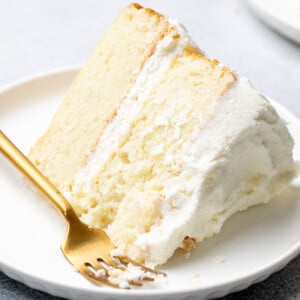
Equipment
- Stand mixer or hand mixer
Ingredients
- 2 cups (280 g) all purpose gluten free flour blend, (I used Better Batter; you must use one of my recommended blends, measure by weight, and sift or the recipe won't work)
- 1 teaspoon xanthan gum, omit if your blend already contains it
- 6 tablespoons (54 g) cornstarch, replace with 6 tablespoons additional Cup4Cup if Cup4Cup is your all purpose gluten free flour
- ½ teaspoon baking soda
- 2 teaspoons baking powder
- ½ teaspoon kosher salt
- 4 (100 g) egg whites, at room temperature
- 1 egg (50 g (weighed out of shell)) at room temperature
- 1 ⅓ cups (10 ⅔ fluid ounces) buttermilk, at room temperature
- 2 teaspoons pure vanilla extract
- 10 tablespoons (140 g) unsalted butter, at room temperature
- 1 ½ cups (300 g) granulated sugar
Instructions
- Preheat your oven to 350°F. Grease 2 8-inch round cake pans and line the bottom of each with a round of parchment paper (trace the perimeter of the cake pan on the parchment, then cut out the circle). Set the pans aside.
- Into a medium-size bowl, sift (yes, you have to sift!) the gluten free flour blend, xanthan gum, and cornstarch. Add the baking soda, baking powder, and salt, and whisk to combine well. Set the dry ingredients aside.
- In a large measuring cup or medium-size bowl, place the egg whites and egg, buttermilk, and vanilla. Whisk to combine very well. Set the wet ingredients aside.
- In the bowl of a stand mixer fitted with the paddle attachment or a large bowl with a handheld mixer, beat the butter and sugar on medium-high speed for at least 3 minutes, stopping at least once to scrape the entire mixture off the sides and bottom of the bowl, or until very light and fluffy.
- To the large bowl with the butter and sugar mixture, add the dry ingredients in 4 equal portions, alternating with the buttermilk and egg mixture in 3 parts, beginning and ending with the dry ingredients and mixing to combine in between additions.
- The batter will sometimes look a bit curdled. That's normal and not a problem at all.
- Once all the ingredients have been added, beat for another minute on medium speed to ensure that everything is combined, then turn over the batter a few times by hand.
- The batter should be fluffy and relatively smooth, although a few lumps are fine. Do not overmix the batter in an attempt to make it perfectly smooth. It will be relatively thick.
- Divide the batter evenly between the two prepared baking pans and smooth each into an even layer with an offset spatula. Bang the bottoms of the pans flat on the counter a few times to break any large air bubbles.
- Place the baking pans in the center of the preheated oven and bake for 20 minutes. Rotate the pans, and continue to bake until the cakes are lightly golden brown all over, have begun to pull away from the sides of the pan and do not jiggle in the center at all (about another 10 minutes). These tests for doneness are more useful than the toothpick test. Do not overbake.
- Remove the cakes from the oven and allow to cool in the pans for 15 minutes before turning out onto a wire rack (and removing the parchment paper liners) to cool completely before frosting and serving.
Video
Notes
Nutrition
Nutrition information is automatically calculated, so should only be used as an approximation.

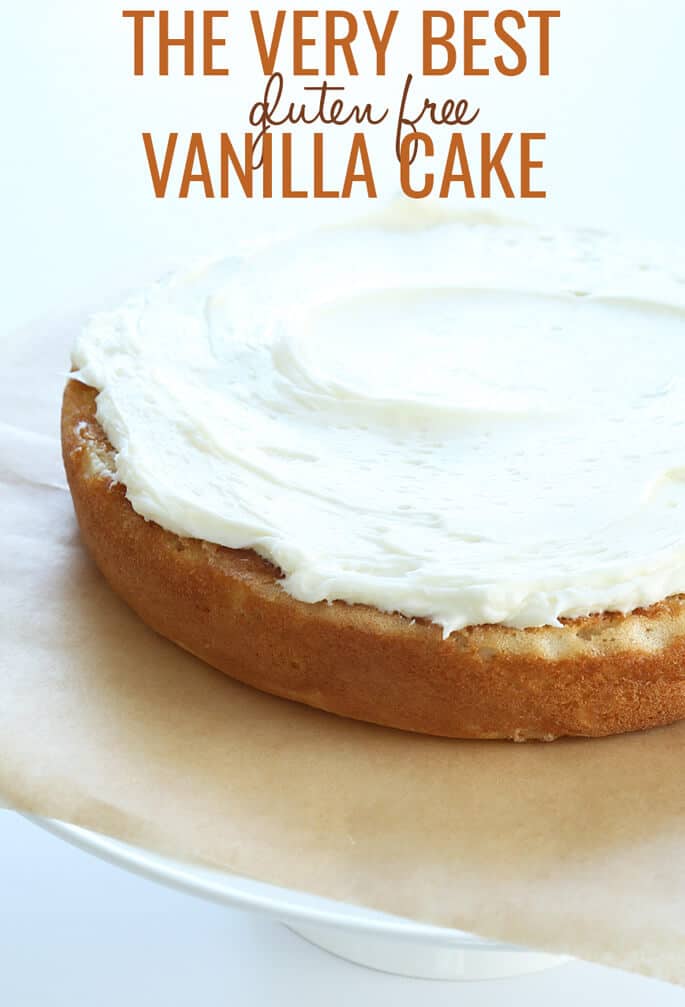
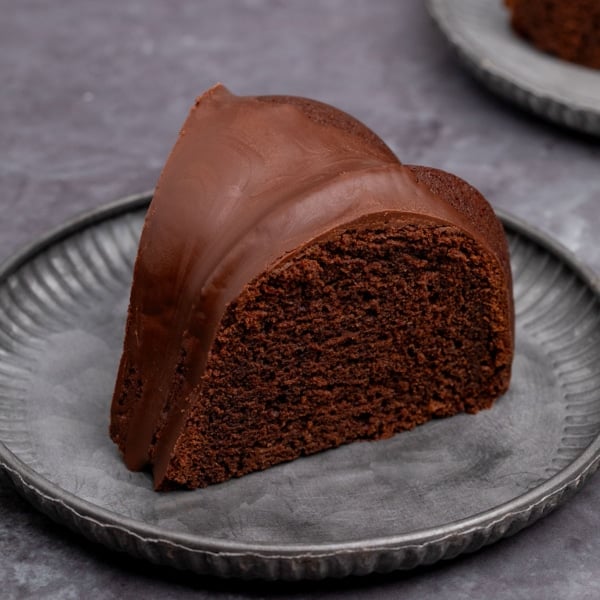

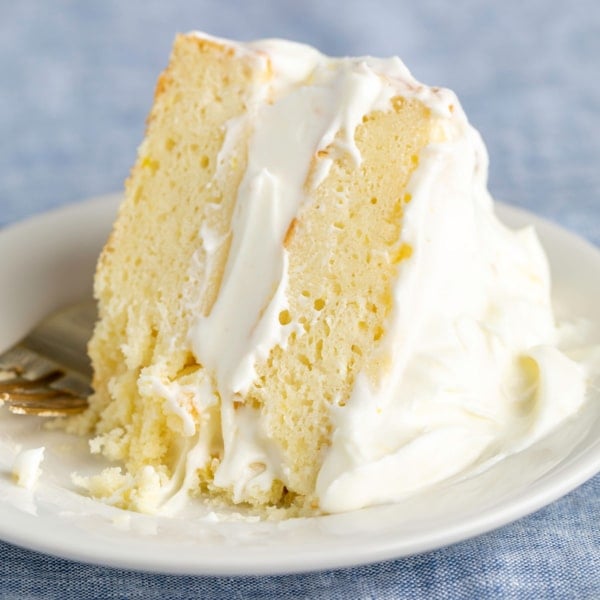
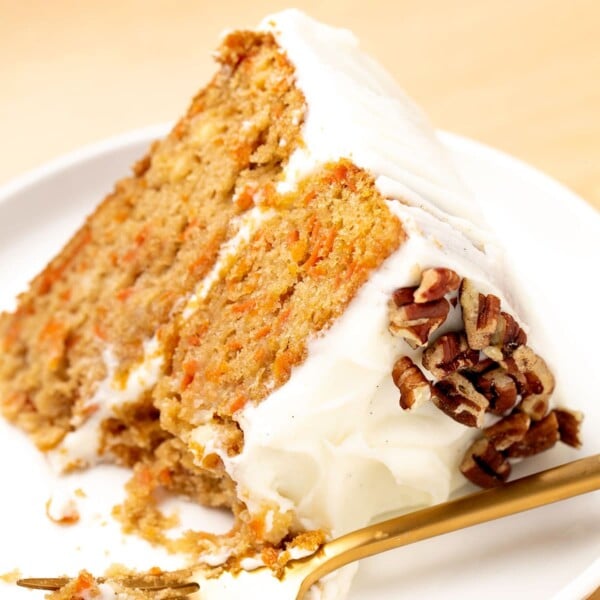









I’m really excited about this recipe and would love to use it, but my son has an allergy to milk (he’s ok when it comes to butter, just not milk) is there any way I can substitute the buttermilk with a non-dairy milk?
Thanks for your time and the recipe!
Jessica
Hi, Jessica,
Please see the post under the heading “How to make this a gluten free dairy free vanilla cake”
It’s not simple to find your type flours
We do have Red mill varieties can those be used – I see your note that nothing else will work –
Yes, I do realize that it can be difficult to source the individual flours which I why I prefer to buy the blends I recommend already mixed. But most of the flours on the market, in particular Bob’s Red Mill, will not produce the results you see and read about in this post.
Oh my god. This cake- the best. I’ve been using a gf cake box mix and jello pudding recipe for my cakes. But they’ve been weak, too sweet and unreliable. But this cake!? Perfect. I like to make my vanilla cake with a fruit compote filling and this cake can withstand the fruit juices. Previous recipes would just turn to mush. This cake is strong, but smooth and not too sweet. I even had to use substitutes like margarine for the butter and half sour cream/ half milk for the buttermilk. Thank you! I know I can always trust your recipes.
You should write my recipe descriptions forever, Carrie! “Strong, but smooth and not too sweet” Yes! So glad you enjoyed it. It’s worth the trouble!
Had anxiety using gf white wings flour in Australia as I couldn’t find some ingredients to create the flour blend. This recipe still came out absolutely perfectly even with the normal flour. I used this recipe for a wedding cake and it held very well with 6 layers and cake sticks. It transported well too and was so fluffy and delicious!! Everybody couldn’t believe it was gf and the bride and groom were extremely happy. Soooo good!! I snuck a lot of slices haha. Thank you!
Is your oven temperature made for a convection oven or conventional?
A conventional oven, Julie. Convection ovens bake very differently and you should never assume convection unless specified. I wouldn’t hide that information from you!
Do you think it would work well if I added sprinkles to make this a funfetti cake? I’ve tried someone else’s recipe for GF funfetti and it tasted like cornbread.
I have a recipe for birthday cake that I think you’d like. That has funfetti in it.
I followed the recipe to the dot, I used a scale. It was wonderful. No body could tell that it was gluten free. Everyone said it’s perfect (I personally could have gone for a little less sweet).
I added strawberry whipped cream and cut up strawberries on top.
Delicious !!
It’s worth the effort! So glad you enjoyed this favorite cake so much.
If I’m using the better batter GF flour do I still need to add the xantham gum or does that flour blend already contain it?
Nope. Since Better Batter already has xanthan gum, you don’t add more. If you did add more, I’d be really specific about that.
This is my favourite- a light fluffy soft cake
Thank you for the recipe
I use a generic gf flour and what i has in the pantry
I did use a chocolate icing in the centre layer and over the cake
Absolutely amazing does not even taste gluten free!! I used Robin Hood gluten-free flour, was sure to weight out ingredients, and ensure ingredients were at room temperature. Cakes turned out amazing. Thank you for this recipe!
I used this recipe as a starting point for a cake I wanted to make using the Better than Cup4Cup gluten free flour recipe (which is amazing too) and it was incredible. The texture and lift for this recipe is on point. I did rest my batter for 10mins but I’m not sure if it was necessary.
I’m glad you enjoyed the cake, Robin! Resting the batter is not necessary, and in fact isn’t a great idea as chemical leaveners are activated upon being added to water-based ingredients, so you want to get the cake into the oven quickly.